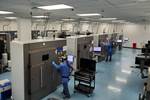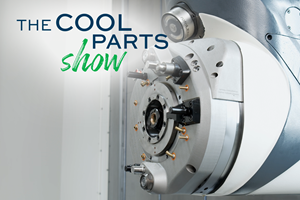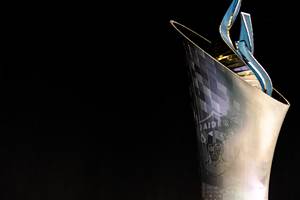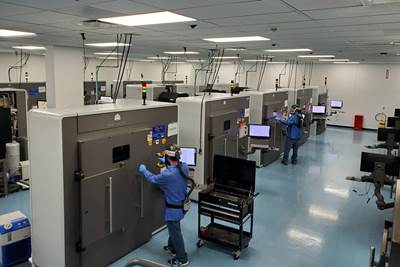Share
Read Next
RMS Additive’s 30 laser powder bed fusion machines, running around the clock to make more than 10,000 medical implants every month, makes the shop the largest-scale metal AM producer our editors have seen. Earlier this year, RMS graciously opened its doors to us, and cohost Pete Zelinski and I were able to see how additive production operates at this scale. RMS team members also discussed with us their commitment to additive, the struggles of staffing an additive facility, the differences in price economics between additive and subtractive manufacturing, and why they’re tired of printing test specimens. Listen above to learn more, or read on for the transcript and notes.
Transcript
Pete Zelinski
Welcome to AM Radio, the show where we tune into what’s happening in additive manufacturing. On this episode, Julia Hider and I took a trip recently to this fully realized high volume production operation using laser powder bed fusion. Julia recently posted two different articles about our experience, so I asked her into the studio to talk with me about what we saw. Additive manufacturing for scale production coming up on this episode.
Julia Hider
This episode of the AM Radio podcast is brought to you by PTXPO, the show for North American plastics professionals. Join Additive Manufacturing Media and sister brand Plastics Technology for the first ever edition of this event in March of 2022. Find more information at plasticstechnologyexpo.com.
Pete Zelinski
I’m Pete Zelinski, and I’m in the studio with Julia Hider.
Julia Hider
Hello.
Pete Zelinski
So Julia, on the previous episode of this podcast, you were in this conversation about the connection between animals and additive manufacturing, right?
Julia Hider
Yes, yes, it was very exciting.
Pete Zelinski
It was very exciting. Everyone should go check out that episode. It was a lot of fun.
Julia Hider
Everyone should go check it out so we can justify making more episodes… a part two.
Pete Zelinski
Well, I’m about to do a follow on to that. So in that episode, I wasn’t there. It was our friend Stephanie who was feeding you images, and you were looking at them sort of one after another responding to them, reacting to them. Cute animals who all had a story to tell about additive manufacturing. So I have one more cute animal photo. Here is a scene of animals with a connection.
Julia Hider
Oh my gosh, okay. I know what this is, I know exactly what this is.
Pete Zelinski
All right, so first, I want you to describe to the listener what you’re seeing in this photo, and then I’m going to ask you if you remember where this was taken.
Julia Hider
Yes, so this is a group of wild turkeys that are outside of this manufacturing facility that we visited. It was very surprising because I’ve only ever seen wild turkeys way out in the country, and it felt like we were in suburbia and we were driving past the building, trying to figure out where to pull into the driveway to park, and there was like five wild turkeys just sitting outside the door.
Pete Zelinski
We parked in the visitor space like we’re supposed to, the manufacturer is RMS, who we’re about to talk to, and they were blocking our way to the door.
Julia Hider
It felt a little intimidating. Like we had to get past this gang of turkeys to get into the building.
Pete Zelinski
So here at Gardner Business Media, we have geese sometimes.
Julia Hider
A lot of geese.
Pete Zelinski
Every once in a while, there’s a hostile one. That sort of crossed my mind, but it turns out the turkeys were there because there’s this nature preserve.
Julia Hider
Yeah, we definitely asked about that, and they explained that there was a nature preserve nearby, and the turkeys sometimes leave the nature preserve and hang out near the building.
Pete Zelinski
And it turns out turkeys — non-threatening, aloof, graceful animals. They just sort of sauntered off.
Julia Hider
They allowed us in.
Pete Zelinski
We were there, visiting RMS in the Minneapolis area. Why don’t you tell everybody about RMS? What is this company? What are they all about?
Julia Hider
Yeah, so they are part of Cretex Medical, which is a parent company that owns several other companies that are involved in or support medical manufacturing. RMS is the largest of this family of companies, and it is a large company. Just to give a sense of the scale that we’re talking about, RMS is 350,000 square feet. When we visited, they said they had 650 machine tools, 1,100 employees and they ship 3 and a half million components per month. Most of that is CNC machining, not additive manufacturing, but it’s a huge company. Then just on the additive side, they have 30 laser powder bed fusion machines and a number of CNC machine tools that are just completely dedicated to machining the 3D printed parts, and they can print I think they said as many as 18,000 parts per month. Pete, you have more experience than me, you’ve seen a lot more facilities. How does this compare to other additive facilities that you’ve seen before?
Pete Zelinski
So, it is a huge additive manufacturing production operation. 30 laser powder bed fusion machines all going, all running round the clock, producing medical implant components. Unless I’m forgetting something, I don’t think I’ve seen a metal additive part production operation of that scale. And as you were describing, this facility itself is huge. I mean, even if you were, if you were going to ask me the same question about machining, I don’t know that I’ve seen many machining facilities with that many machine tools going all at once, but within this company, within that facility, they have grown this big successful additive manufacturing production operation. These things that we often talk about, the promise of additive for production … it’s not promised for RMS. It’s what they’re doing, and they’re producing a lot of product. You listed the potential capacity that they cited to us. I think the figure they quoted, like, right now at the. at the level that they’re running they are making 13 to 15,000 implants per month additively, and as you said, an additive manufacturing operation of that scale has to entail its own machining operation too. You ended up writing about the additive workflow, and then for our sister publication Modern Machine Shop, you wrote specifically about that machine shop. I think we’re going to talk about all of it.
Julia Hider
That is a lot of cover, but I think we can do it.
Pete Zelinski
So, we talked to a lot of people at RMS. They were great to us. We got kind of an extensive tour.
Julia Hider
They were.
Pete Zelinski
Talked to a lot of people, kind of a fast conversation. It was Troy Olson, who’s their director of operations for the additive manufacturing division. He’s the one who kind of organized all this, but certainly he’s not the only source we talked to there. It’s going to be impossible to link everything we learn to every individual we met, but at the end of this, let’s try to list out the people we met and thank them because we had such a great visit there. Yeah, all right. Where should we start? I think I’ve got some like big picture themes I want to ask you about and I want to kind of talk about, and one of them is just sort of their choice to commit to additive. This is something they identified years ago that they wanted to get into. Like let's start talking about that.
Julia Hider
Yeah, I thought the way that they got into additive was really interesting because they’re, you know, an FDA registered manufacturer. They can see what their customers are submitting and look at the FDA filings, and from those filings, they were able to tell that not only were their customers experimenting with additive manufacturing, they were specifically working with 3D Systems. So that’s how they decided not only to get into additive, but it’s also how they chose which machine to go with.
Pete Zelinski
So that was, I think, the time frame that you’re describing was around 2013 or 2014.
Julia Hider
Yeah, I think that’s right.
Pete Zelinski
That led to 2015. Troy Olson told us the start of this. They went to the leadership of the company saying, “I think it’s going to take at least $1,000,000 to get started with this, and we have no idea if it’s going to work.”
Julia Hider
Yeah, they said they had no customers at that point, and they didn’t have any experience with metal 3D printing, but they knew that if they were going to do it, they had to commit to it. So they got this machine with, you know, no customers, no experience, and they knew they had to commit the time to figuring it out. So for the first year, they didn’t advertise what they were doing or that they had this capability, and they just focused on learning the machine and the software and the powder handling, and they even brought on a consultant, Ryan, who now works for the company and we spoke to him as well. He was the one who helped them figure out how to get it started.
Pete Zelinski
So 2015... was that conversation about, “Give us $1,000,000 to try this.” Lik,e I almost never go to our bosses just asking for $1,000,000. 2016 was when that first machine landed. I think we learned it wasn’t until 2018 that they sent out their first invoice for production parts. There was that level of development and that level of ramp up, and it speaks to [how] additive is such a different technology and such a different way of producing. It just takes a commitment to go through that learning curve to integrate it into what we’re already doing, what RMS was already doing. I think that time frame sort of speaks to the commitment and the consistency of intent that they brought to this determination that additive was going to be the way forward for them.
Julia Hider
Yeah, the fact that they were able to go from one machine to 30 in five years. That’s pretty amazing.
Pete Zelinski
Their experience kind of challenges something I thought I had seen and assumed up until that point. I thought I had noticed the way that established, successful manufacturers actually have a challenge getting into additive manufacturing because it’s really hard to keep advancing and sustaining and supporting your current successful process while in parallel you do this whole other strange different thing. But RMS pulled off exactly that. Another successful additive manufacturing company that comes to mind is Sintavia in Florida, and the leader of that business made the point that like, “Yeah, part of the reason we were able to succeed is because we didn’t burn our boats behind us. We had no boats to burn.” And RMS had all these other boats. They kept the boats going really well, and then they like built and launched this other very different boat in parallel with that.
Julia Hider
Yeah, I think the key to that was that they treated it as an entirely separate thing. You know, like at one point, Ryan said, (when we were talking about how they were setting up a separate machine shop to machine these parts) “We didn't want additives screwing up what was already a really good machine shop.” They had to sort of treat it as its own thing with its own resources, and I think that was key to them being able to do that.
Pete Zelinski
Yeah, so totally. That is so well said. They kept it separate and they staffed it separately. Like, let’s talk about the staffing ... so 30 machines, 15 people devoted to the additive group.
Julia Hider
Yeah, I think that’s right.
Pete Zelinski
So, compare that ratio to other types of manufacturing to start with. If I saw a machining facility with 30 CNC machine tools or a molding facility with 30 injection molding machines, I would expect more than 15 people to be staffing that organization.
Julia Hider
Or they have a bunch of robots, which RMS does. Well, they have a pretty cool robot. But that’s a separate story.
Pete Zelinski
So those 15 people … where did they come from?
Julia Hider
So yeah, one of the points they made was that they have to train all of their additive employees in house, and because they do both additive and machining, it was interesting to hear their differences and perspectives on how to hire the two. They have a pipeline for hiring machinists, but there’s no pipeline for hiring 3D printer operators. Troy said, “If we put out an ad for someone to run a 3D Systems machine, no one’s going to answer that ad,” so they have to train everybody in house. When you’re training someone to run a 3D printer, at least at RMS, it’s more than just running the 3D printer. They have to do powder handling and sieving and machine maintenance, and they run the wire EDMs that separate the parts from the build plate and removing support structures and quality inspection, so there’s a lot that they have to train for.
Pete Zelinski
It’s all trained in house, as you say. These team members are homegrown. Yeah, that word 3D printer covers a whole range of different types of devices and these machines, particularly these machines as RMS maintains them because, in the interest of having identical capacity from machine to machine, they upgrade every one with all the latest bells and whistles as they get a new machine so they stay alike. So these are sophisticated pieces of equipment [with] a lot going on and a lot of steps. They’ve done a great deal to systemize all that. Staffing is part of the challenge they had to rise to in this learning curve the organization was going through. It’s like every team member was going through their own individual learning curve at the same time.
Julia Hider
Yeah, I want to go back to something that you had just mentioned about standardization and how they have 30 machines and they’re all basically the same machine, but not really because they bought them at different times. So, whenever they get a new machine, they have to upgrade the older ones to ensure that they all have the same capabilities, and they’re totally flexible and they can swap them out.
Pete Zelinski
So that standardization, it, like, translates to procedures too. The crash cart, wasn’t that cool? They’ve got a standard cart that they’ve equipped with all of the resources needed to do job changeover on one of these machines. The standard items on that cart speak to the standard of procedures each of these homegrown operators is trained for in order to get each machine finished with its current job and back into production quickly. The other thing about the cart is the way it’s part of the room equipment — it’s a very minimalist space that all these 3D printers are in. It’s part of the way that this metal additive room is equipped. It’s how they do job changeover, like moving one build plate out, moving another build plate in. The build plate: fundamental to metal additive, fundamental to the way they’ve had to think about the work. Like, can you talk about that a little bit?
Julia Hider
Yeah, this is an interesting point that I’d never really thought about because normally in manufacturing if you get an order for 1,000 parts, that order is one job, but with metal AM, Troy was saying you have to break that order down into build plate quantities and then every build plate becomes its own job. So if that thousand part order is broken down into — what did we say — 40 build plates and that’s 40 separate jobs, then that in turn totally changes the economics of the manufacturing. The price doesn’t go down the more parts that you order, and that’s a big jump for customers to realize that.
Pete Zelinski
So customers have a hard time with that, like the volume discount concept doesn’t really apply to additive. There’s no, there’s no tooling to amortize because that big job actually becomes a bunch of little jobs. The 40 build plates are kind of 40 different jobs moving through the process. How do they think about what they put on each plate?
Julia Hider
Yeah, this is, uh, and another interesting point that they were making is that they put you know, different test specimens like tensile testing bars on every build plate, but you know that means more paperwork, and at a certain point in the workflow test, specimens are split from the rest of the parts on the build plate. But then it all has to come back together at the end, so it kind of adds a lot more complication the more test specimens you add.
Pete Zelinski
They talked a lot about this, and it’s a super important point and a subtle one. The quantity of parts that they put on each plate ... they’re looking at time increments and they want, they want each build to fall within a set amount of time. But that leaves all this space. That’s a lot of times it leaves extra space on the build plate and the customer thinks that they are just for the purposes of validation and safeguarding [so we] might as well add more test coupons and test specimens, but that adds cost. It adds time. We heard some things about questions that they’re trying to answer about the effectiveness of tensile bars, for example.
Julia Hider
Yeah, they said that they’ve been gathering all of this data from all of the builds they’ve been doing since day one, and now they’re going through it to see if they can make the case that they don’t need to include a tensile bar on every build plate. You know, if they’ve never failed in 10 years and they do regularly scheduled maintenance with test specimens, they still have to include them with every build because they’re adding time and money.
Pete Zelinski
What do tensile bars really show? And RMS is manufacturing at such a volume that they’re actually in a position to, in a kind of sophisticated way, be able to answer that question?.
Julia Hider
Yeah, you know they were pointing out that sometimes when a customer is designing a process, it’s easy to just throw all these test specimens on there, but then they’re stuck with that quality plan for as long as they’re making that part. But if they take the time upfront and think about what they really need, then they can save the time and money down the line.
Pete Zelinski
Okay, so that’s that was all the additive stuff, but, but we say all the time, like additive manufacturing is not just 3D printing. It is a process that has 3D printing at its heart. There’s all this other stuff you have to do too. For RMS, that means machining after the break.
Can we nerd into machining a little bit? Of course. All right, that’s coming up, stick around.
Related Content
8 Cool Parts From Formnext 2023: The Cool Parts Show #65
New additive manufacturing technologies on display at Formnext were in many cases producing notable end-use components. Here are some of the coolest parts we found at this year’s show.
Read More3D Printed Cutting Tool for Large Transmission Part: The Cool Parts Show Bonus
A boring tool that was once 30 kg challenged the performance of the machining center using it. The replacement tool is 11.5 kg, and more efficient as well, thanks to generative design.
Read More3D Printed Metal Component for CNC Machining Center: The Cool Parts Show #47
Machine tool maker DMG MORI improved this coolant delivery adapter by making the part through additive manufacturing instead of machining. One of the viewer-chosen winners of The Cool Parts Showcase.
Read MoreThe World’s Tallest Freestanding 3D Printed Structure
Dimensional Innovations paired additive and subtractive manufacturing to create a monument for the NFL’s Las Vegas Raiders new stadium. The “never been done before” project resulted in the world’s tallest freestanding 3D printed structure.
Read MoreRead Next
AM for Production: Where Conventional Lessons Do and Do Not Apply
As RMS has grown its additive manufacturing division, it has discovered which principles of subtractive manufacturing apply to additive, and which do not.
Read More4 Ways the Education and Training Challenge Is Different for Additive Manufacturing
The advance of additive manufacturing means we need more professionals educated in AM technology.
Read MoreHybrid Additive Manufacturing Machine Tools Continue to Make Gains (Includes Video)
The hybrid machine tool is an idea that continues to advance. Two important developments of recent years expand the possibilities for this platform.
Read More












.png;maxWidth=300;quality=90)











